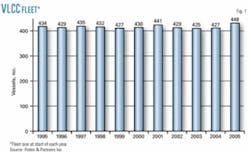Current newbuilding orders for VLCCs will increase the size of the fleet through at least 2009. Many vessels will have to be ordered for delivery between 2010 and 2015, however, to compensate for required phaseouts, according to Poten & Partners, an international energy and ocean transportation brokerage and consulting firm based in New York.
The VLCC fleet size has been static during the past 10 years (Fig. 1). The stable fleet size results from annual scrapping activity being roughly equal to newbuild deliveries until 2004, when scrapping activity declined significantly (Fig. 2).
Even though the VLCC fleet has stagnated numerically, productivity has increased; the double-hull vessels built in the 1990s and 2000s are faster, larger, more fuel-efficient and operate more days per year than those being scrapped.
“Faster” is a matter of fuel economics, reflecting the relationship between speed and fuel consumption for diesel vs. steam-turbine propulsion.
Operating days per year for newbuilds are understandably higher than for older vessels, which require more off-hire time repairs and maintenance.
Combined, such effects make newer VLCCs approximately 20% more productive than the vessels they are replacing. Consequently, the fleet can cover greater ton-mile demand with the same number of vessels.
Accelerated phaseout
In 2003 the International Maritime Organization (IMO) accelerated the initial enforcement date for phaseout of single-hull tankers set out by the International Convention for the Prevention of Pollution from Ships (Marpol) to Apr. 5, 2005. Single-hull tankers must now cease operating by 2010, unless they pass a condition-assessment scheme (CAS) survey. If a vessel passes the survey, its required phaseout can be extended according to the survey’s findings, but not beyond 2015. Additionally, tankers with either double sides or double bottoms are to operate until their twenty-fifth anniversary or 2015, whichever occurs first.
The age profile of the current single-hull VLCC fleet shows that few would face mandatory phaseout before 2010, as 95% are less than 20 years of age (Fig. 3).
Future supply
The accelerated Marpol regulations will, however, send 119 VLCCs to the scrap yard that will be 20 years old or younger unless they pass a CAS survey.
The new, stricter limits will have a major impact on future vessel supply.
In 2004, and through August 2005, few vessels have been scrapped, converted to FPSOs or permanent floating storage, or put to other uses. Should this trend continue, newbuilding deliveries will cause the VLCC fleet to swell until 2010, when 164 VLCCs will have to be removed from service (assuming that 8 vessels are scrapped before 2010).
This trend generates a fleet development curve not before seen, said the Poten study, with vessels continuing to be delivered even as removals wane but with any perceived surplus vanishing abruptly.
Next big jump
The sinking of the VLCC Erika off the coast of France in late 1999 (OGJ, Dec. 20, 1999, p. 38) and the sinking of the VLCC Prestige (OGJ, July 28, 2003) off the coast of Spain in 2003 introduced age preference into the chartering decisions of oil companies, reducing supply below physical availability and helping drive an unprecedented rise in charter rates.
The new Marpol provision on single-hull phaseout will have an even greater impact on vessel supply, according to Poten & Partners.
Many additional VLCCs will need to be ordered to compensate for tonnage that will be lost by 2015. These orders, however, will come at a time when berth availability, due to demand for other types of vessels, is strained.✦



